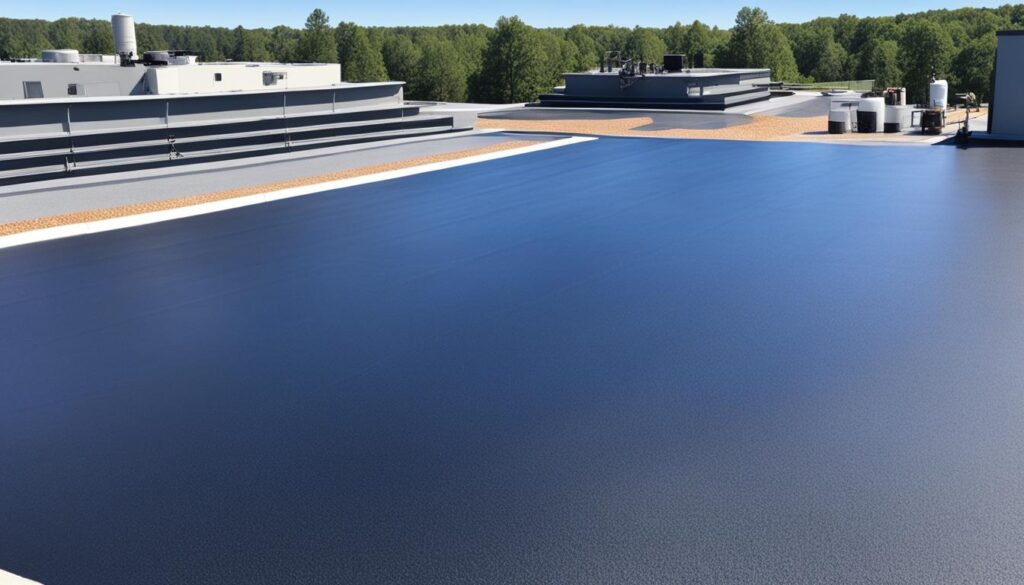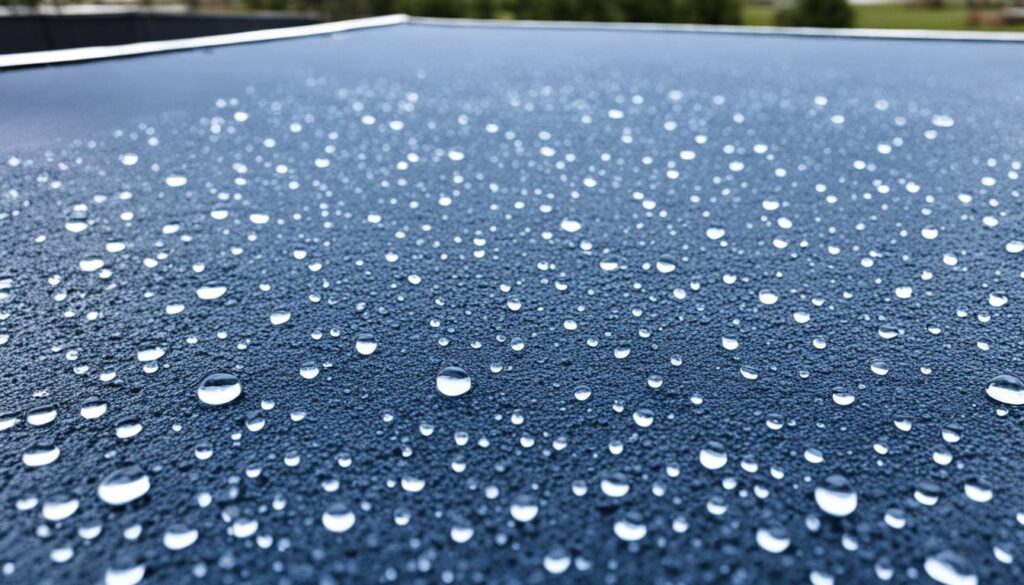Are you tired of dealing with leaks and water damage on your flat roof? Finding the right waterproofing solution is essential to protect your property and ensure its longevity. But with so many options available, how do you choose the best one?
At XYZ Roofing, we’ve got you covered. In this article, we’ll explore the top flat roof waterproofing solutions, including TPO roofing membrane, PVC roofing membrane, and EPDM roofing membrane. We’ll discuss their unique features, benefits, and considerations, helping you make an informed decision for your flat roof. So let’s dive in and discover the secure and durable options for your flat roof!
Key Takeaways:
- Flat roofs require waterproofing solutions to prevent leaks and water damage.
- The recommended flat roof waterproofing options are TPO roofing membrane, PVC roofing membrane, and EPDM roofing membrane.
- TPO roofing membrane is a white, heat-reflecting option suitable for both living and non-living spaces on flat roofs.
- PVC roofing membrane offers flexibility and resistance to chemicals and weather, making it ideal for complicated roof systems.
- EPDM roofing membrane is a durable black synthetic rubber option, but it absorbs heat and is not recommended for living spaces.
Roof Waterproofing Methods for Flat Roofs
Flat roofs are prone to various issues such as leaks, ponding, and blistering due to their exposure to the elements. Effective roof waterproofing methods are crucial to prevent these problems and ensure the longevity of the roof. Here are some commonly used methods for waterproofing flat roofs:
-
Single-Ply Membranes: Single-ply membranes are popular options for flat roof waterproofing. They are flexible, durable, and easy to install. Three commonly used single-ply membranes are:
- TPO Roofing Membrane: TPO (Thermoplastic Olefin) roofing membrane is a white, heat-reflective option suitable for both living and non-living spaces on flat roofs. It can last around 25 years and provides excellent resistance against UV rays.
- PVC Roofing Membrane: PVC (Polyvinyl Chloride) roofing membrane is similar to TPO but offers more flexibility. It is ideal for complicated roofing systems and provides resistance against chemicals and weather. PVC roofing membranes also last around 25 years.
- EPDM Roofing Membrane: EPDM (Ethylene Propylene Diene Monomer) roofing membrane is a black synthetic rubber option. While it absorbs heat, it is highly durable and can last up to 30 years. It’s not recommended for living spaces due to heat absorption, but it’s a reliable choice for flat roofs.
- Reinforced Bitumen Membranes: Reinforced bitumen membranes involve multiple layers and provide substantial waterproofing. They are commonly used in commercial and industrial applications where durability is essential.
- Liquid Rubber Coating: Liquid rubber coating is a durable option for flat roof waterproofing. It requires multiple coats for effectiveness and provides a seamless, protective layer. This coating is excellent for sealing cracks and preventing leaks.
- Patch and Seal Tape: In case of temporary emergency repairs, patch and seal tape can be used effectively. It provides a quick fix for sealing tears or small punctures in roof membranes.
These methods offer a range of options for flat roof waterproofing, each with its own advantages and considerations. Choosing the right method depends on factors such as budget, aesthetic preferences, durability requirements, and the specific needs of the building.
Implementing proper roof waterproofing methods not only prevents water damage but also improves the overall structural integrity of the building. Consulting with a professional roofing contractor is recommended to ensure the correct application of the chosen waterproofing method and to maintain the roof’s condition over time.
Benefits and Considerations of Different Flat Roof Waterproofing Options
When it comes to flat roof waterproofing, there are several options available, each with its own set of benefits and considerations. Understanding the advantages and potential drawbacks of different materials will help you make an informed decision for your project. Let’s take a closer look at the benefits and considerations of three popular options: TPO roofing membrane, PVC roofing membrane, and EPDM roofing membrane.
TPO Roofing Membrane
TPO roofing membrane offers numerous benefits for flat roofs. One of its key advantages is its ability to reflect heat, which can help keep the interior of a building cooler and reduce energy costs. Additionally, TPO membranes are available in various sizes and can be aesthetically appealing due to their white color, making them a versatile choice for both commercial and residential projects.
PVC Roofing Membrane
PVC roofing membrane is another popular choice for flat roof waterproofing. It is known for its flexibility, making it suitable for complicated roofing systems with unique shapes and contours. PVC membranes also provide excellent resistance to chemicals and weather, offering superior protection against leaks and deterioration. Like TPO, PVC membranes are available in white, enhancing their energy efficiency by reflecting sunlight.
EPDM Roofing Membrane
EPDM roofing membrane is a durable option that can withstand harsh weather conditions and is resistant to UV radiation. Although it is commonly used for commercial and industrial applications, it can also be suitable for residential projects. However, it’s essential to consider the heat absorption properties of black EPDM membranes, as they can lead to increased indoor temperatures if installed over living spaces. Regular maintenance is also required to ensure the longevity of EPDM membranes.
When choosing a visible roofing option, it’s crucial to consider the implications of the white color for TPO and PVC membranes. While these membranes offer excellent durability and energy efficiency, they may require periodic cleaning to maintain their appearance. On the other hand, EPDM membranes require less aesthetic upkeep due to their black color but are not recommended for living spaces due to their heat absorption properties.
Ultimately, the choice between TPO, PVC, and EPDM roofing membranes will depend on factors such as budget, aesthetic preferences, and the specific requirements of your project. Consulting with a professional roofing contractor can help you make an informed decision and ensure proper installation and maintenance of your flat roof waterproofing system.

Alternative Flat Roof Waterproofing Solutions
When it comes to flat roof waterproofing, there are alternatives to traditional shingles that can offer better durability and water shedding capabilities. Two popular options are modified bitumen and TPO roofing membrane, which provide cost-effective solutions for flat roofs. In addition, liquid rubber coating and patch and seal tape offer temporary emergency repairs for leaks and tears in roof membranes.
Modified Bitumen
Modified bitumen is an asphalt-based solution that provides enhanced durability and improved water shedding compared to traditional shingles. It comes in different colors and can be a great alternative for flat roofs.
TPO Roofing Membrane
TPO roofing membrane is a single-ply system that offers strong seams through heat welds. It is an economically feasible option for flat roofs and can be installed over existing roofs in certain conditions.
Liquid Rubber Coating
Liquid rubber coating is a durable option for sealing cracks and flashings on flat roofs. Although it requires multiple coats and curing time, it provides long-term protection against leaks and water damage.
Patch and Seal Tape
For temporary emergency repairs, patch and seal tape can be a convenient solution. It effectively seals tears and provides a quick fix to prevent further damage to the roof membrane.

These alternative flat roof waterproofing solutions offer cost-effective options for ensuring the longevity and protection of flat roofs. Whether it’s modified bitumen, TPO, liquid rubber coating, or patch and seal tape, there are multiple choices available to meet different needs and budgets.
Conclusion
Flat roof waterproofing is a critical aspect of maintaining a secure and durable roofing system. By preventing leaks and other issues, it ensures the longevity and structural integrity of your flat roof.
Membrane roofs, such as TPO, PVC, and EPDM, are popular choices for flat roof waterproofing. Each membrane option has its own set of benefits and considerations, allowing you to customize your waterproofing solution to suit your specific needs.
When selecting a flat roof waterproofing solution, it’s important to take into account factors such as aesthetics, durability, and heat absorption. By considering these aspects, you can choose a membrane that not only provides excellent waterproofing but also aligns with your aesthetic preferences and offers long-lasting performance.
To ensure the proper installation and maintenance of your flat roof waterproofing system, it is crucial to partner with a reliable and experienced roofing contractor. They have the expertise and knowledge to handle the intricacies of flat roof waterproofing, ensuring that your roof is properly protected and maintained over time.

Meet William Adams, a seasoned roofing expert with over 30 years of hands-on experience in the industry. Having worked tirelessly under the scorching sun and through the fiercest storms, William brings a wealth of knowledge and expertise to the table. Hailing from the heart of the USA, he’s witnessed the evolution of roofing practices firsthand, mastering every aspect along the way. Now retired from the field, William spends his days cherishing time with his loved ones while sharing his invaluable insights through this platform. With William at the helm, you can trust that every tip, advice, and recommendation provided is backed by years of real-world experience and unwavering dedication to quality craftsmanship. Join us as we journey through the world of roofing, guided by the wisdom and passion of a true industry veteran.

